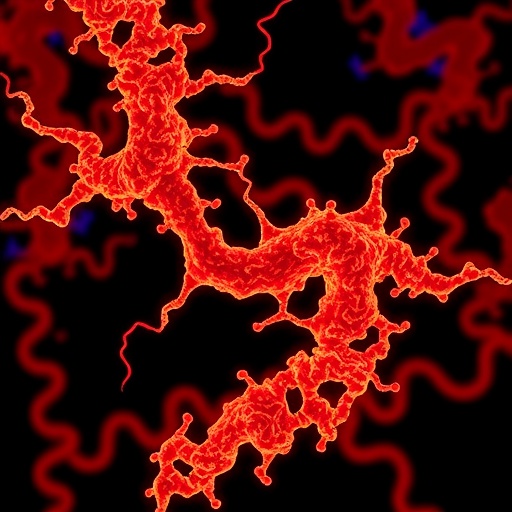In recent research published in Molecular Diversity, authors Tang, Ma, and Zhang delve into the intriguing world of protein allostery, specifically focusing on the SIRT6 protein. This particular study brings to light the mechanistic intricacies of how the N-terminal domain of SIRT6 facilitates allosteric regulation — a phenomenon crucial to understanding the protein’s biological roles. The integration of molecular dynamics simulations and biochemical assays has enabled the researchers to paint a comprehensive picture of the mechanisms at play, offering insights that could potentially lead to novel therapeutic strategies targeting this important protein.
SIRT6, a member of the sirtuin family, has caught the attention of researchers due to its involvement in critical cellular functions including DNA repair, metabolism regulation, and aging processes. The multifunctionality of SIRT6 is underscored by its complex structural attributes, particularly how variations in the protein’s conformation can translate into diverse functional outcomes. This makes the study of its allosteric behavior essential, as it reveals how external signals can orchestrate significant changes in protein functionality through spatial rearrangements.
The research team employed molecular dynamics simulations to probe the structural changes in SIRT6’s N-terminal domain. These simulations provided a dynamic view of the protein’s behavior over time, allowing the researchers to observe the fluctuations and transitions that might be otherwise missed in static structural analyses. By creating a virtual environment where SIRT6 could interact with various biomolecular partners, the simulations yielded valuable data on how allosteric sites are influenced by conformational shifts, an area of particular interest in systems biology.
Biochemical assays were conducted to complement the computational findings and to verify the actual biological activities associated with allosteric modulation in SIRT6. These experiments allowed the researchers to measure enzymatic activities in real-time, providing evidence for their hypotheses regarding the N-terminal domain’s role in regulating SIRT6’s function. The interplay between in silico predictions and in vitro validations showcases a powerful duality in experimental approach that often enhances the reliability of research findings in molecular biology.
One of the most compelling aspects of this study is the identification of specific amino acid residues within the N-terminal domain that are crucial for allosteric regulation. By pinpointing these key residues, the researchers have opened pathways for targeted manipulations of SIRT6 function. This information could be harnessed to develop inhibitors or activators capable of modulating SIRT6 activity, a promising avenue in the therapy of diseases where SIRT6 plays a critical role, such as cancer and metabolic disorders.
The implications of the findings extend beyond theoretical interests; practical applications could emerge in drug design aimed at diseases influenced by SIRT6 activity. For example, understanding how to effectively enhance or inhibit SIRT6 function through small molecules or genetic editing could lead to substantial improvements in treatment regimens for age-related diseases or conditions characterized by chronic inflammation.
Moreover, the research highlights the significance of allosteric sites as potential drug targets – a concept that has gained traction in pharmacology. By focusing on the N-terminal domain of SIRT6, the study underscores a broader lesson applicable to the development of therapeutics directed at various proteins that exhibit allosteric behavior, expanding the toolkit available to modern medicine.
As SIRT6 continues to be a focal point in the quest to understand the biology of aging and metabolic regulation, the findings of this research serve as a critical stepping stone toward more nuanced therapies that can leverage the complexities of protein structures. The ability to manipulate allosteric mechanisms offers a sophisticated approach over traditional methods that typically involve direct binding at active sites, emphasizing the role of protein dynamics in therapeutic innovations.
In conclusion, the work undertaken by Tang, Ma, and Zhang offers crucial insights into the mechanistic basis of N-terminal domain-mediated allostery in SIRT6. By integrating advanced molecular dynamics simulations with careful biochemical validation, this study lays the groundwork for future explorations in protein regulation and its implications for health and disease management. These findings capture the essence of multidisciplinary research, where computational and experimental methods converge to deepen our understanding of biological systems.
Researchers and clinicians alike are encouraged to explore the possibilities arising from these findings, propelling SIRT6 into the forefront of therapeutic research. The potential to modulate its activity through an allosteric lens holds promise not just for elucidating fundamental biology but also for translating these insights into therapeutic breakthroughs that could reshape the landscape of treatment for metabolic and age-related diseases.
By highlighting the interconnectivity between molecular dynamics and practical applications in health, this research stands as a testament to the power of innovation in the life sciences, inspiring future studies that aim to untangle the complexities of protein function and regulation.
Subject of Research: Allostery in SIRT6 protein
Article Title: Mechanistic basis of N-terminal domain-mediated allostery in SIRT6: integrating molecular dynamics simulations and biochemical assays
Article References:
Tang, H., Ma, W., Zhang, G. et al. Mechanistic basis of N-terminal domain-mediated allostery in SIRT6: integrating molecular dynamics simulations and biochemical assays.
Mol Divers (2025). https://doi.org/10.1007/s11030-025-11340-1
Image Credits: AI Generated
DOI: 10.1007/s11030-025-11340-1
Keywords: SIRT6, allostery, N-terminal domain, molecular dynamics, biochemistry, protein structure, therapeutic targets




